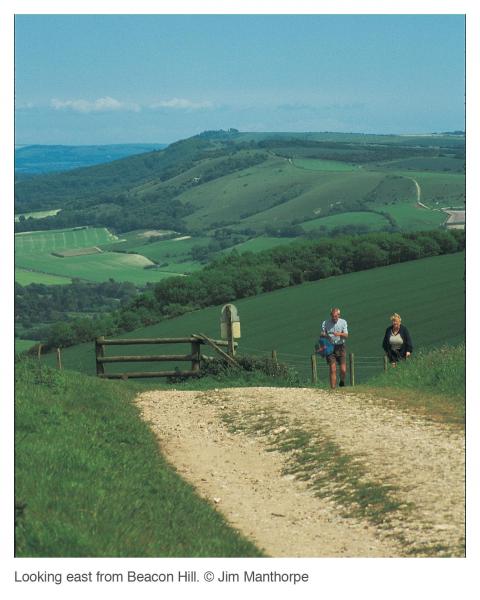Worth watching out for.
— John Cleare

South Downs Way
Excerpt:
About the South Downs Way
Contents list | Introduction | About the South Downs Way | Practical information for the walker | Itineraries | Using this guide | Sample route guide and maps: Exton to Buriton | Stage map and profile: Winchester to Exton
History
There has been a long-distance route running along the top of the South Downs for far longer than walking has been considered a leisure activity. The well-drained chalk hilltops high above the densely forested boggy clay below were perfect for human habitation and were certainly in use as far back as the Stone Age.
From this time onwards a complex series of trackways and paths developed across the land and it is believed that by the Bronze Age there was an established trade route along the South Downs. All along the crest of the Downs escarpment there is evidence of Iron Age hill-forts and tumuli (ancient burial grounds), many of them very well preserved, particularly the Old Winchester hill-fort site in Hampshire.
In more recent times the land was cleared and enclosed, and the flat hilltops were put under the plough. Although this process erased many of the lesser tracks the most significant of them remained; the one which ran east–west along the edge of the escarpment. It was not until 1972, amid rapidly growing public interest in walking, that the Countryside Commission designated the 80 miles from Eastbourne to the Sussex–Hampshire border the first long-distance bridleway in the UK. Later, the final section through Hampshire was added bringing the length of the South Downs Way to one hundred miles and giving it a spectacular start in the historic city of Winchester. Today the route is growing in popularity with walkers, cyclists and horse-riders alike, all of whom tend to mingle with ease.

How difficult is the path?
The South Downs Way is one of the most accessible and easiest of Britain’s long-distance paths. Those on foot will find the route usually follows wide, well-drained tracks in keeping with its designation as a long-distance bridleway, catering for cyclists and horse-riders as well as walkers. If anything walkers may, on occasion, crave a few more lightly trodden paths since the route always sticks to the well-beaten track.
This one-hundred-mile walk can be conveniently divided into sections starting and stopping at any of the numerous little villages that sit at the foot of the escarpment or in a fold in the hills. One thing to note, though, is that because the Way generally follows the high ground along the top of the South Downs, to reach the villages offering accommodation, pubs and shops you usually have to descend steeply off the Downs and climb back onto them to continue, which can make pub lunches less attractive! When calculating the day’s timings you need to bear in mind this extra walking time involved.
How long do you need?
Walkers will find that the whole route can be tackled over the course of a week but it is well worth taking a couple of extra days to enjoy the beautiful downland villages that are passed along the Way. It is also worth taking time to explore the former capital of Saxon England, Winchester, a historic town with a beautiful cathedral. At the other end of the walk Eastbourne, to be polite, is perhaps a little less interesting but will keep those who like to sit on a windy seafront happy for hours. The practical information in this section will help you plan your walk and design an itinerary to meet your particular preferences.
South Downs Way
Excerpts:
- Contents list
- Introduction
- About the South Downs Way
- Practical information for the walker
- Itineraries
- Using this guide
- Sample route guide and maps: Exton to Buriton
- Stage map and profile: Winchester to Exton
Price: £14.99 buy online now…
Latest tweets